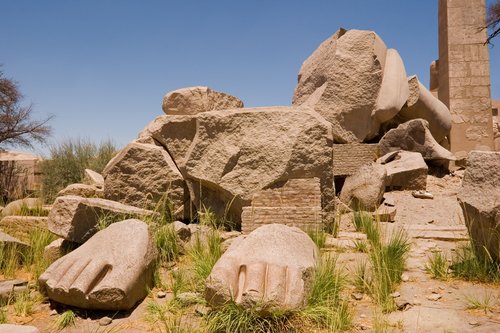A few thoughts, in no particular order:
- This poem
is existential and political at once, focusing on the impermanence of human
creations, especially the eventual fall of tyrants. I find it interesting that <i>nothing</i>
would remain of the ancient tyrant were it not for the “hand that mocked” him;
the creation’s endurance perpetuates knowledge of the king. Yet this does not
mean Ozymandias’ goal is achieved; the statue, rather than striking awe into
the heart of the viewer, prompts him to reflection and melancholy instead.
Reflecting
Shelley’s political views, the tyrant’s message becomes ironic while the
sculptor’s artistry is preserved. In fact, nature has vindicated the artist’s
mockery of authority: the last words are given to the “lone and level sands,” blending
human intention and natural fate. It is in keeping with transcendentalist views
of art and fate.
- Regarding form, I suppose
it must be a sonnet, as it is composed of fourteen lines of iambic pentameter,
but the rhyme scheme is not that of a classic Petrarchan (abbaabbacdecde) or
Shakespearean (ababcdcdefefgg) sonnet or even any recognizable variation upon
them. It runs as follows: abacadedfeghgh The last four lines fit together in a
recognizable pattern, but the rest of the poem does not. There are patterns
that do not repeat (as abba or abab would in a classical sonnet), do not
resolve, and overlap each other. For instance, d is both part of an axaxax
pattern and a dxdx pattern. In every other work by Shelley that we have read,
he sets himself a pattern and follows it throughout the piece. Furthermore, in “Ozymandias,”
nearly every line is enjambed. This reflects the wearing away of edges, the
loss of definition of the statue and Ozymandias’ legacy over time.
- This image, found on planetware.com, is of
the ruins of a statue of Ramses II, Ozymandias. It could be that Shelley was referring
to a real statue. The mental image his poem conjures up is far more “romantic,”
however—much more impressive. Artists basing their work off this poem seem to draw
impossibly huge structures. Search Google or art websites such as DeviantArt for
“Ozymandias” and ignore all the Watchmen results to see what I mean. (I’m not vouching for the quality of the art you’ll find, only the
size of the statue/ruins!) I cannot pinpoint what exactly in the poem makes the ruins seem so huge and desolate, but it seems to affect more people than just me.
- I do have a nagging question regarding the poem. It is a story within a story, told by “a
traveler from an antique land.” Who is this traveler? Why was he in Egypt? Who
is he telling this story to, and why? I somehow doubt Shelley just stuck him in because he needed a first line.

I think Shelley stuck in the traveller because it emphasizes that Ozymandias is not remembered (in the recounting of a memory) as Ozymandias, but rather as simply a fallen statue, which happens to have an inscription on it. Only the statue itself indicates it is of Ramses II-- neither the speaker nor the traveller refer to the statue as Ramses II/ Ozymandias, which makes readers acutely aware of the irony produced by the juxtaposition of the inscription and the setting.
ReplyDelete